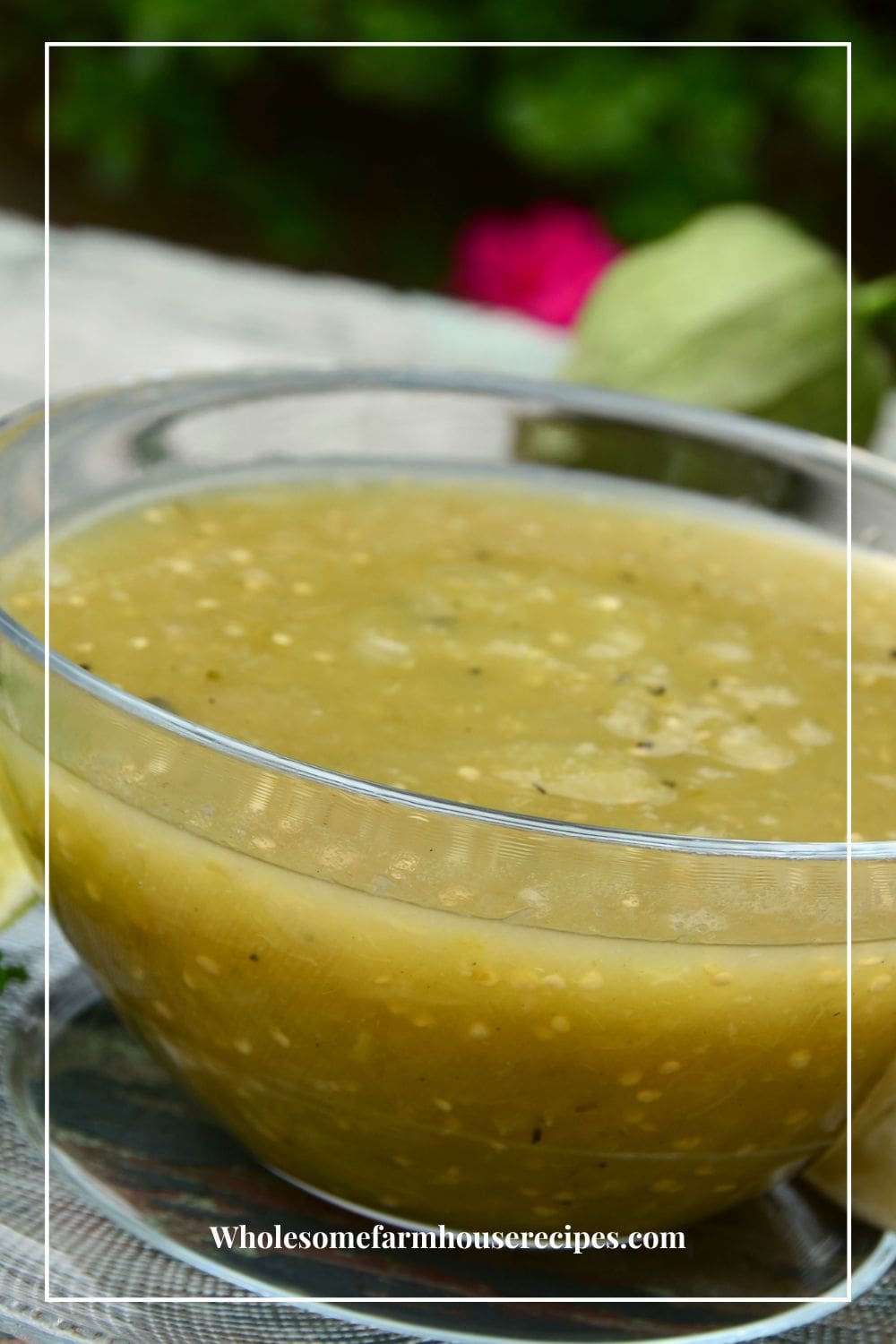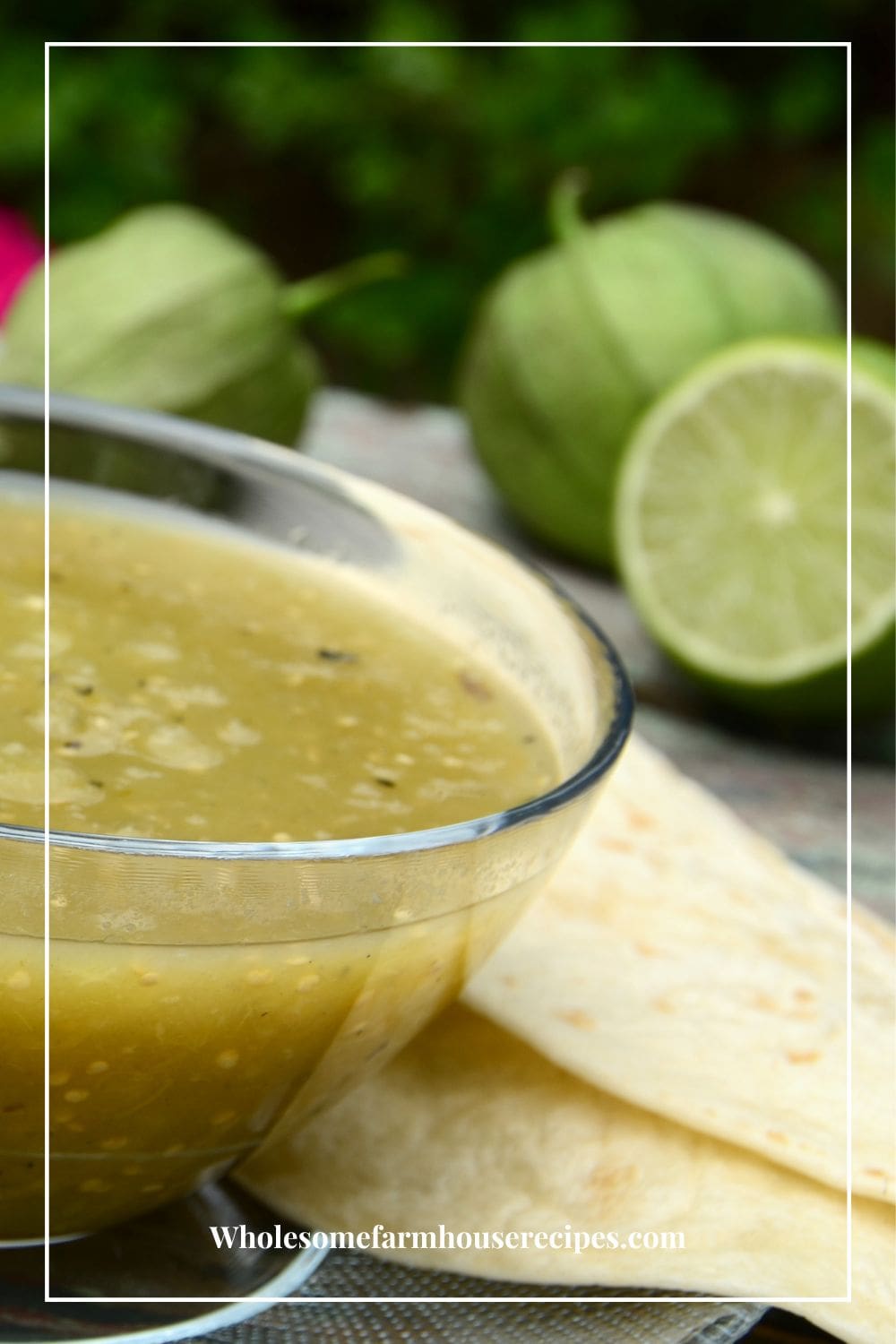Make your own Homemade Tomatillo Salsa Verde. When you make salsa at home, you have control over the freshness of each ingredient. You can handpick the ripest tomatillos, freshest cilantro, and perfectly ripened limes, ensuring a burst of flavor in every bite.
Tailor the recipe to your taste preferences. Whether you like it extra spicy, tangy, or with a hint of sweetness, you can adjust the ingredients to create a personalized salsa that suits your palate.
Further, store-bought salsas often contain preservatives to prolong their shelf life. When you make it at home, you can skip the preservatives and enjoy a salsa that’s free from artificial additives, colors, and flavors.
There’s a special satisfaction that comes from creating something delicious from scratch. When you make salsa at home, you can experiment with different variations and ingredients. Add mango for a fruity twist or roasted poblano peppers for a smoky flavor. The possibilities are endless, and you have the creative freedom to make it uniquely yours.

An easy way to make this is using a food processor. Another authentic salsa verde recipe from everyday southwest uses the air fryer.
What is Salsa Verde Made of?
Ingredients in a Basic Tomatillo Salsa Verde. It’s a tangy and slightly spicy sauce that is a staple in Mexican cuisine. The ingredients for a basic salsa Verde recipe are tomatillos, fresh garlic, cilantro, jalapeño, and salt.
Today, we’re diving into the world of flavors with a zesty twist as we unveil the secrets behind crafting your very own Tomatillo Salsa Verde.
Homemade Tomatillo Salsa Verde Recipe
As an Amazon Associate I earn from qualifying purchases.
Kitchen Essentials
Ingredients
- 1 Pound Tomatillos with the husks removed
- 3 Cloves Garlic
- 1 Jalapeno Pepper
- ½ Cup White Onion Diced
- ½ Cup Cilantro Coarsely Chopped
- 1 Teaspoon Kosher Salt
- 2 Tablespoons Water
Instructions
- Preheat the oven to 425°F.
- Remove the husks from 1 pound of tomatillos and rinse them under cold water.1 Pound Tomatillos
- Peel 3 cloves of garlic and remove the stem from 1 jalapeño pepper.3 Cloves Garlic, 1 Jalapeno Pepper
- Place the tomatillos, garlic, and jalapeño on a baking sheet and roast for 6 minutes.
- Remove the baking sheet from the oven and let the ingredients cool for a few minutes.
- Transfer the roasted ingredients to a blender or food processor.
- Add 1/2 cup of diced white onion, 1/2 cup of coarsely chopped cilantro, 1 teaspoon of kosher salt, and 2 tablespoons of water to the blender.½ Cup White Onion, ½ Cup Cilantro, 1 Teaspoon Kosher Salt, 2 Tablespoons Water
- Blend the ingredients until they are smooth and well combined.
- Taste the salsa and add more salt if needed.
- Enjoy your homemade salsa Verde with tortilla chips, tacos, or any other Mexican dish of your choice.
Your Own Private Notes
Nutrition
What are tomatillos?
Tomatillos are small, round, green fruits that are part of the nightshade family, along with tomatoes, peppers, and eggplants. They are native to Central and South America and are a staple in Mexican cuisine. Tomatillos are often mistaken for green tomatoes, but they are not the same fruit.
Tomatillos are enclosed in a papery husk that needs to be removed before use. They look like small green tomatoes. They have a tart, slightly citrusy flavor and a firm texture when raw, which softens and sweetens when cooked. Commonly, they are used to make the best salsa verde. A popular green salsa in Mexican cuisine, as well as in various sauces, soups, and stews.
According to The Taste of Home, they are rich in vitamins A and C, as well as potassium and fiber, tomatillos are not only delicious but also nutritious additions to your meals. Whether roasted, boiled, or blended into sauces, tomatillos add a unique and vibrant flavor to dishes, making them a versatile ingredient in the kitchen.

What’s the difference between green taco sauce and salsa verde?
“Green taco sauce” and “salsa verde” are terms that are sometimes used interchangeably, but there can be subtle differences in their ingredients, flavors, and uses. Here’s a general overview of the distinctions:
Salsa Verde. Typically includes tomatillos as the main ingredient, which are small green or yellow fruits with a tart flavor. Known for its bright, tangy flavor due to the tomatillos. Can have a fresh and slightly citrusy taste.
May also contain green chili peppers, onions, garlic, cilantro, and lime juice.
The texture can range from chunky to smooth, depending on personal preference and regional variations.
It’s a versatile condiment used in Mexican cuisine, great for topping tacos, enchiladas, grilled meats, or as a dip for tortilla chips.
Green Taco Sauce. The base can vary, and it might include tomatillos, green tomatoes, or green chili peppers.
Additional ingredients often include onions, garlic, vinegar, and various spices. The flavor can vary but often includes a combination of tanginess, heat, and savory notes.
Some green taco sauces may have a more processed or vinegar-forward taste compared to the fresh and bright profile of salsa verde.
Tends to be more processed and often has a smoother, pourable consistency. Sometimes used for tacos, burritos, and other Mexican-inspired dishes as a finishing sauce, marinade, or condiment.
In summary, while the terms are sometimes used interchangeably, “salsa verde” often emphasizes a fresh, homemade sauce with tomatillos, while “green taco sauce” may refer to a more commercially produced product with a broader range of ingredients.
However, these distinctions can vary, and the specific products you encounter may blur the lines between the two. Always check the ingredient list and flavor profile to get a better sense of what you’re working with.

What can I do with a jar of salsa verde?
A jar of salsa verde from grocery stores is a versatile ingredient that can add a burst of flavor to various dishes. We always have one in our pantry. If we are lucky, the local farmers market will have raw tomatillos. If you have the fresh ingredients, it just take a few minutes to make your own fresh salsa.
Sometimes, it’s called a green sauce. Serve at room temperature. Here are several creative and delicious ways to use it:
1. Tacos and Burritos. Use as a flavorful topping for tacos or burritos. It pairs well with a variety of proteins such as grilled chicken, pork, shrimp, or even vegetarian options like roasted vegetables or black beans.
2. Enchiladas. Pour over enchiladas before baking to add a zesty and tangy element. It works particularly well with chicken or cheese enchiladas.
3. Eggs. Jazz up your breakfast by drizzling over scrambled eggs or making a breakfast burrito.
4. Dips and Appetizers. Mix with cream cheese, sour cream, or Greek yogurt to create a tasty dip for tortilla chips or veggies. You can also use it as a topping for nachos.
5. Grilled Meats. Marinate chicken, pork, or beef in salsa verde before grilling for an extra kick of flavor. It adds a delicious charred and tangy taste.
6. Rice and Grain Bowls. Stir into cooked rice or grains for a flavorful and vibrant base for your bowl. Top with your favorite proteins and vegetables.
7. Soups and Stews. Add a dollop to soups or stews for an instant flavor boost. It works particularly well in chicken or vegetable-based soups.
8. Pork enchiladas verdes. This is one of our favorite salsas to serve with our pork carnitas.

Add a Southwestern Twist to Recipes
8. Salads. Use as a dressing for salads. It adds a refreshing and unique flavor.
9. Quesadillas. Spread inside quesadillas for a burst of flavor. Combine it with cheese, veggies, and your protein of choice for a quick and tasty meal.
10. Fish Tacos. Elevate your fish tacos by drizzling over grilled or fried fish. The bright, tangy flavors complement the seafood beautifully.
11. Baked Potatoes. Mix with sour cream and use it as a topping for baked potatoes. It adds a unique twist to a classic dish.
12. Sandwiches and Wraps. Spread on sandwiches or wraps for an extra layer of flavor. It pairs well with deli meats, grilled chicken, or even roasted vegetables.
13. Pasta. Stir into cooked pasta for a quick and flavorful sauce. Add vegetables, protein, and cheese for a complete meal.
14. Casseroles. Add to casseroles for a boost of flavor. It works well in Mexican-inspired casseroles with ingredients like rice, beans, and cheese.
15. Dipping Sauce for Snacks. Use as a dipping sauce for snacks like chicken wings, mozzarella sticks, homemade tortilla chips, corn chips, or jalapeño poppers.
How to store homemade salsa verde recipe?
To store Tomatillo Salsa Verde properly and ensure it stays fresh and flavorful, follow these steps:
- Transfer the salsa to a clean, airtight container: Use a glass or plastic container with a tight-fitting lid such as mason jars. It’s essential to choose a container that’s just the right size to minimize air exposure.
- Seal the container tightly: Make sure the lid is securely closed to prevent air from entering the container, which can cause the salsa to spoil more quickly.
- Refrigerate promptly: Place the sealed container of Tomatillo Salsa Verde in the refrigerator as soon as possible after making it. Refrigeration helps slow down the growth of bacteria and keeps the salsa fresh for longer.
- Use within a week: Tomatillo Salsa Verde will typically stay fresh in the refrigerator for about 5 to 7 days. Check the salsa for any signs of spoilage, such as off odors or mold, before consuming it.
- Consider freezing for longer storage: If you want to keep the salsa for an extended period, consider freezing it. Transfer the salsa to a freezer-safe container, leaving some space at the top for expansion, and freeze for up to 3 months. Thaw the salsa in the refrigerator overnight before using it.
By following these storage tips, you can enjoy your homemade Tomatillo Salsa Verde at its best for an extended period.
Get creative, and don’t be afraid to experiment with this tomatillo salsa recipe in your favorite dishes to discover new and exciting flavor combinations.
We have a few more delicious recipes for you to explore.







